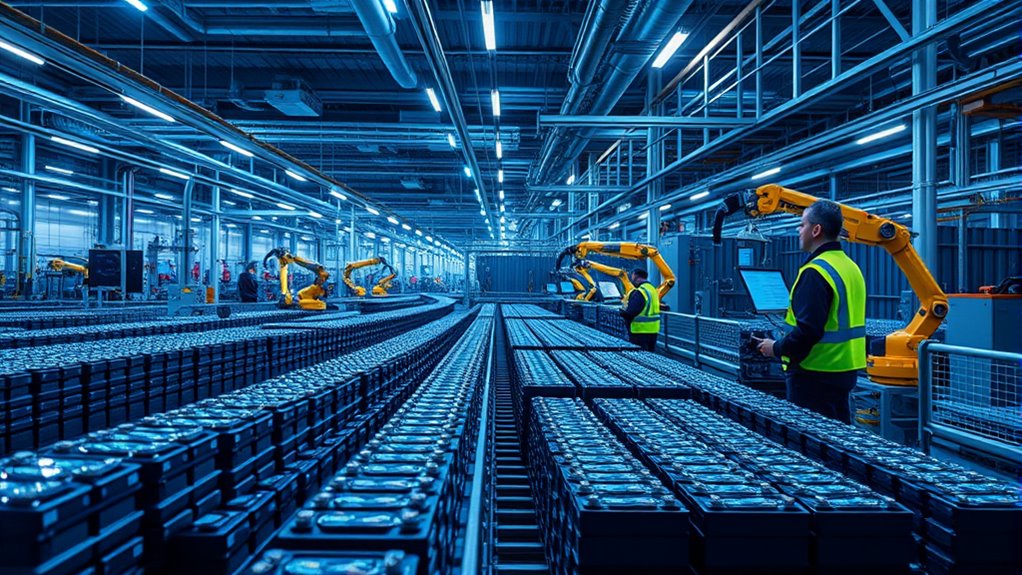BASF and Stena are leading Europe’s efforts to expand a sustainable battery recycling network that promotes a circular economy and boosts energy resilience. They’re developing infrastructure to collect, disassemble, and reuse batteries, reducing reliance on raw materials and cutting environmental impacts. Their work helps create a resilient, local supply chain, supporting Europe’s climate goals. If you want to explore how this innovative network is shaping Europe’s green future, there’s more to discover ahead.
Key Takeaways
- BASF and Stena are leading Europe’s expansion of a sustainable battery recycling network to support EV and renewable energy growth.
- The network focuses on recycling end-of-life batteries to recover critical materials like lithium, cobalt, and nickel.
- Infrastructure development enables battery reuse and localized recycling, reducing transportation emissions and supply chain dependencies.
- These initiatives promote a circular economy, lowering environmental impact and enhancing Europe’s resource resilience.
- The collaboration aims to accelerate Europe’s energy transition and meet climate goals through innovative recycling technologies.

Europe’s push toward sustainable energy solutions is accelerating, and BASF and Stena are at the forefront with their expanding battery recycling network. As the demand for electric vehicles and renewable energy storage grows, so does the importance of establishing a robust circular economy for batteries. Your focus should be on how these companies are transforming the supply chain, making it more sustainable and efficient through innovations in battery reuse. By recycling batteries at the end of their life, you can considerably reduce the reliance on raw material extraction, which is often energy-intensive and environmentally damaging. This shift not only conserves natural resources but also helps stabilize the supply chain, ensuring a steady flow of critical materials like lithium, cobalt, and nickel.
BASF and Stena enhance sustainable supply chains through innovative battery reuse and recycling efforts.
BASF and Stena are actively developing infrastructure that makes battery reuse a practical reality. Instead of batteries ending up in landfills or being discarded prematurely, they’re being collected, disassembled, and processed to extract valuable materials. This process creates a closed-loop system, where batteries can be refurbished or repurposed for secondary uses, such as energy storage for homes or businesses. Such reuse extends the lifespan of batteries, reducing waste and providing a more sustainable solution for energy storage needs. You’ll find that this approach not only conserves resources but also cuts costs across the supply chain, making electric vehicles and renewable energy projects more affordable and accessible.
The expanded network of recycling facilities means that batteries can be processed closer to where they’re used, minimizing transportation emissions and logistical hurdles. This localized approach enhances supply chain resilience, helping Europe reduce dependence on imported raw materials and mitigate supply disruptions. When you prioritize battery reuse within this network, you help create a more circular economy—one where materials are continually recycled and reintegrated into manufacturing processes. This, in turn, supports the continent’s broader climate goals and reduces the environmental footprint associated with battery production.
As you consider the future of energy storage and electric mobility, it’s clear that the efforts led by BASF and Stena are essential. They’re not just expanding recycling capacity; they’re redefining how batteries are integrated into the supply chain. By focusing on battery reuse, they’re helping you build a more sustainable, resilient energy ecosystem. This approach ensures that Europe stays on track toward its ambitious climate targets while fostering innovation and economic growth in the green sector. The collaborative push for sustainable battery management will undoubtedly shape the continent’s energy landscape for years to come.
Frequently Asked Questions
How Will the Recycling Network Impact Electric Vehicle Battery Prices?
This recycling network will likely lower electric vehicle battery prices by improving battery material recovery and making recycling technology innovation more efficient. As you benefit from cheaper batteries, you’ll notice the cost reductions driven by better recycling methods that reuse valuable materials. These advancements reduce dependency on raw material extraction, stabilize supply, and drive down costs, making EVs more affordable for you and encouraging widespread adoption.
What Types of Batteries Will the Recycling Facilities Process?
You’ll see recycling facilities process various batteries, mainly lithium-ion types used in electric vehicles and portable electronics. They handle diverse battery chemical compositions, including lithium, cobalt, nickel, and manganese. Thanks to recycling technology advancements, these facilities can efficiently recover valuable materials, reducing waste and environmental impact. This process enables a sustainable loop, ensuring that different battery chemistries are properly recycled and resources reused for future battery production.
Are There Plans to Expand the Recycling Network Beyond Europe?
Yes, there are plans to expand the recycling network beyond Europe. You’ll see efforts to integrate with the global supply chain, addressing increasing demand and resource sustainability. This expansion could influence policy implications worldwide, encouraging harmonized regulations and standards. As companies aim for a more circular economy, expanding recycling facilities helps guarantee that battery materials are responsibly recovered, reducing environmental impact and supporting global efforts for cleaner energy solutions.
How Does the Recycling Process Ensure Environmental Safety?
You might think recycling is just about tossing batteries in a bin, but it’s far safer than that. The process actually follows strict environmental safeguards and recycling standards, ensuring hazardous materials don’t escape. These measures include advanced sorting, careful chemical handling, and eco-friendly disposal methods. So, when you recycle, you’re not just clearing space, you’re actively preventing environmental harm—proving that safety can be both efficient and responsible.
What Are the Economic Benefits for Local Communities?
You benefit from local job creation and community development when battery recycling facilities open nearby. These plants create new employment opportunities, boosting the local economy and supporting small businesses. As the community grows, infrastructure improves, and residents gain access to better services. This fosters a sense of pride and sustainability, making your area more resilient and attractive for future investments, ultimately enhancing your quality of life.
Conclusion
As you can see, BASF and Stena are really pulling out all the stops to build Europe’s battery recycling network. Their efforts are setting the stage for a greener future, proving that teamwork can turn the tide on waste. It’s clear they’re not just talking the talk but walking the walk. With momentum like this, it’s only a matter of time before the industry hits its stride—showing that when it comes to sustainability, they’re all in it together.










